Peek into the Bible's final chapters, Revelation 21-22, where a new creation and eternal peace await, inviting deep reflection on life's ultimate purpose.
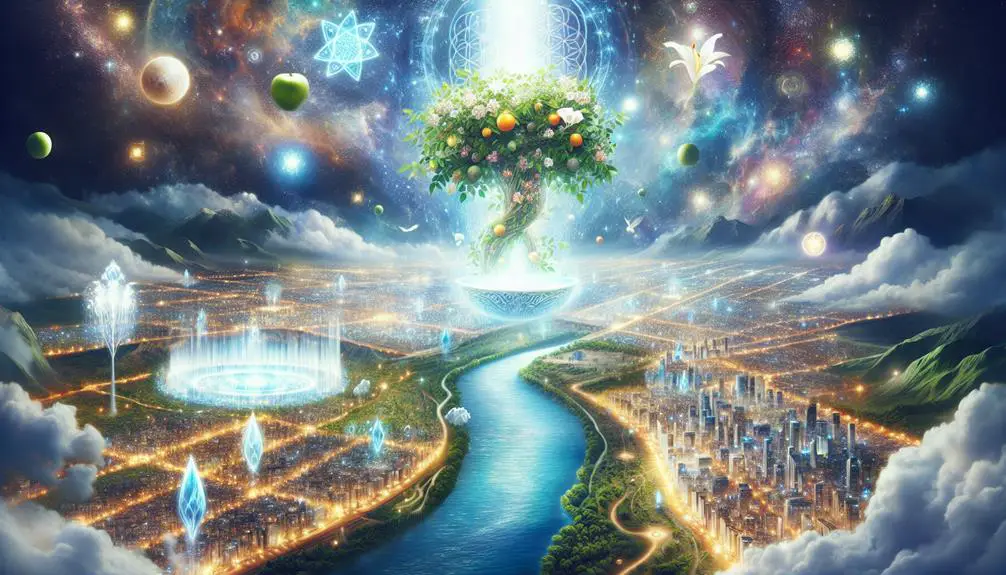
How Does the Bible End in Revelation 21-22
In a world that often seems consumed by chaos, the closing chapters of the Bible, Revelation 21-22, present a stark contrast: a vision of harmony and perfection where God dwells among people in a new creation.
You'll discover a place where suffering, mourning, and death have no hold, and the beauty of the New Jerusalem descends from heaven itself, promising an eternal home for the faithful.
This culmination offers not just an end but a beginning, inviting you into a profound reflection on eternity and your place within it. Curiosity might just lead you to uncover how these final words resonate with your own journey.
Key Takeaways
- Revelation 21-22 envisions a new creation, symbolizing divine fulfillment and eternal harmony under God's rule.
- The New Jerusalem embodies divine-human unity, marking a transition to divine governance and eternal paradise.
- The River of Life represents renewal, purification, and God's endless provision, central to the vision of eternal paradise.
- The conclusion emphasizes salvation for the righteous, warns against defiance, and underscores the eternal consequences of one's choices.
The Vision of a New Creation
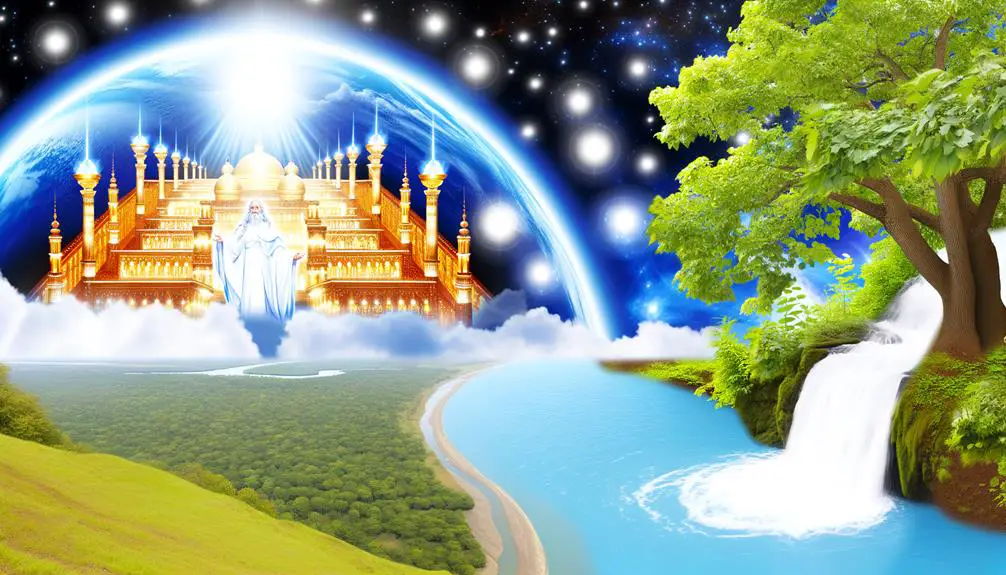
In Revelation 21-22, the narrative unfolds a vision of a new creation, symbolizing a transformative renewal where you, as a reader, are transported into a realm of divine perfection and eternal harmony. This vision isn't merely an end but a cosmic renewal, marking a pivotal moment in the biblical narrative. It's a profound transformation that speaks to the very heart of creation's destiny, inviting you to envision a world reborn, free from the scars of sin and decay.
This cosmic renewal, as depicted in these closing chapters, is crucial for understanding the Bible's comprehensive message of redemption and restoration. Here, creation's transformation is total, affecting not just humanity but the entirety of the cosmos. The imagery employed is rich and multilayered, offering you a glimpse into a reality where the divine presence permeates everything, eradicating the old order of things—pain, suffering, and death are no more.
As you delve deeper into this vision, it becomes clear that this isn't an escapist fantasy but a promise of what's to come. The new creation stands as a testament to the power of divine love and justice, where the relationship between Creator and creation is fully restored. In this renewed world, the barriers that once separated the sacred from the secular are dismantled, revealing a universe suffused with the glory of God.
This vision challenges you to rethink your understanding of the end times, encouraging a perspective that sees the end not as a cataclysmic conclusion but as the dawn of a new era marked by cosmic renewal and creation's transformation.
The New Jerusalem Descends
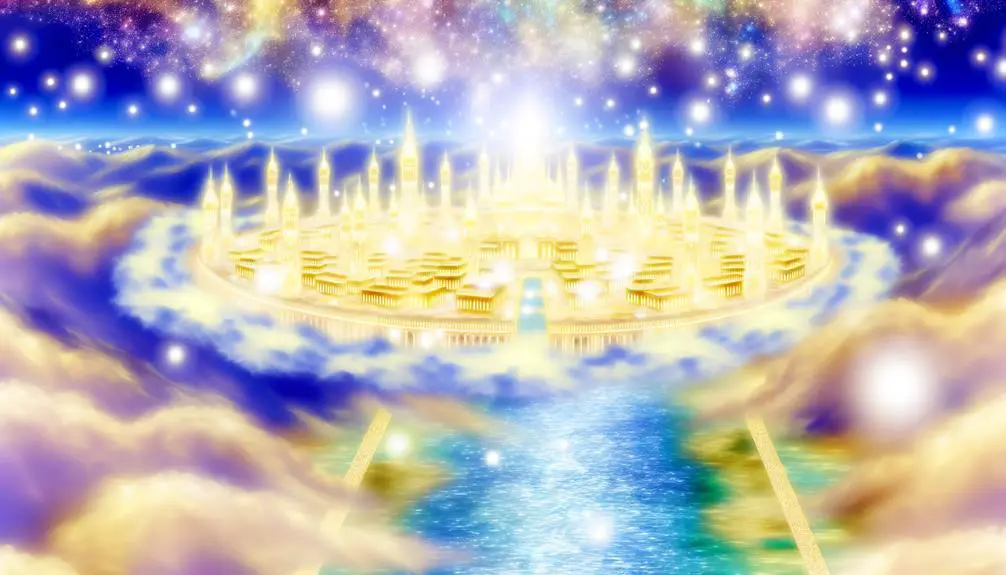
As you explore the descent of the New Jerusalem in Revelation 21-22, you're confronted with its divine origin and the splendor of its construction. This segment unveils how its heavenly genesis and radiant characteristics serve as a culmination of prophetic visions and divine promises.
Analyzing these aspects reveals the intricate relationship between the city's celestial beginnings and its role as a symbol of eternal salvation and God's unending glory.
City's Heavenly Origin
Descending from the realm of the divine, the New Jerusalem symbolizes the culmination of God's promise to humanity, marking a transformative moment in biblical eschatology. This heavenly city, as portrayed in Revelation 21-22, isn't just a metaphor for eternal bliss but a tangible representation of divine architecture and celestial governance. Its origin is celestial, embodying:
- The fulfillment of divine prophecy.
- The manifestation of God's kingdom on Earth.
- A transition from earthly to divine governance.
- The blending of heavenly perfection with human society.
Through this lens, the New Jerusalem serves as a bridge between the divine and the mortal, reflecting a unique fusion of celestial design with the ultimate goal of unity under God's sovereign rule.
Glorious Features Revealed
Building on the celestial origins of the New Jerusalem, the scripture meticulously outlines its glorious features, revealing a city whose divine craftsmanship sets a new benchmark for perfection. This imagery, steeped in celestial and apocalyptic prophecy, serves not just as a literal description but as a rich, symbolic tapestry that communicates the culmination of divine promises.
The New Jerusalem's descent, as detailed, isn't merely an event within the apocalyptic narrative but a transformative moment where the heavenly and earthly realms converge in unparalleled splendor. Through this, the text invites you to perceive beyond the physical dimensions, urging a deeper contemplation on the spiritual significance of this celestial city. Here, the apocalyptic prophecy transcends its historical context, offering a vision of eternal harmony and divine presence.
God Dwells Among People
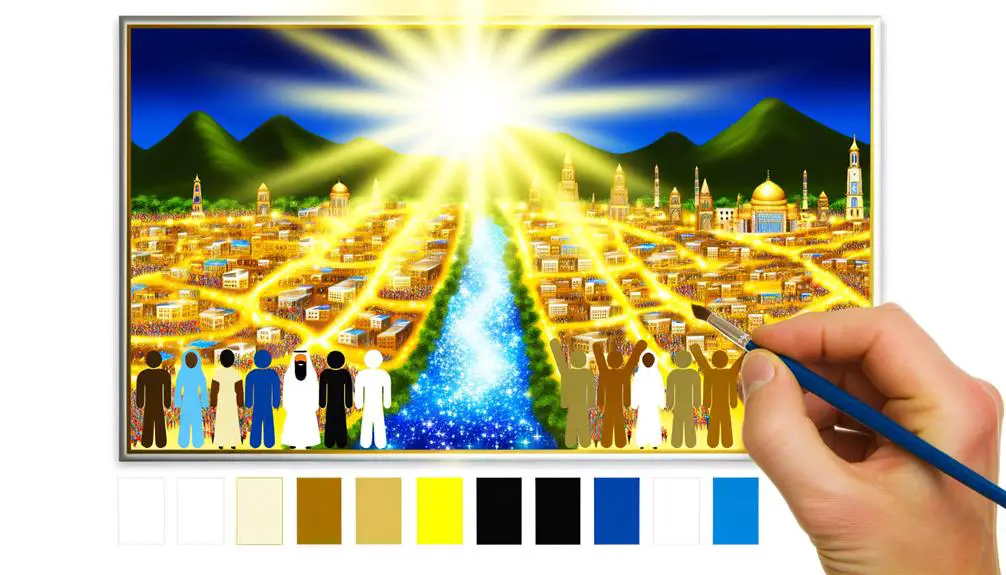
In Revelation 21-22, the text vividly portrays God's presence among humanity, marking a transformative era where divine and mortal realms converge. This convergence isn't merely symbolic but deeply integral to the theme of human redemption. Through divine presence, a holistic restoration is envisioned where the barriers that have historically separated the Creator from the creation are dismantled. This scenario articulates a profound theological vision that accentuates both the immanence and transcendence of God.
- Immanence of God: The text underscores God's closeness, indicating that He'll dwell among people, sharing in their realities and experiences. This closeness signifies a relationship characterized by intimacy and accessibility.
- Transcendence of God: Despite God's closeness, His holiness and sovereign authority aren't diminished. The divine presence among humanity in Revelation is a reminder of God's supremacy and the ultimate authority over all creation.
- Restoration of Eden: The imagery of God dwelling among people harks back to the Edenic state, where God walked with Adam and Eve. This return to an Eden-like communion symbolizes full human redemption and the restoration of the intended relationship between God and humanity.
- Symbol of the New Jerusalem: The New Jerusalem, described as descending from heaven, serves as a powerful symbol of this divine-human convergence. It's a tangible representation of God's kingdom established among men, where His presence is an everlasting reality.
Analyzing these elements reveals that Revelation 21-22 doesn't merely depict an end but heralds a new beginning—a future where divine presence facilitates an eternal communion and the fulfillment of human redemption.
No More Suffering
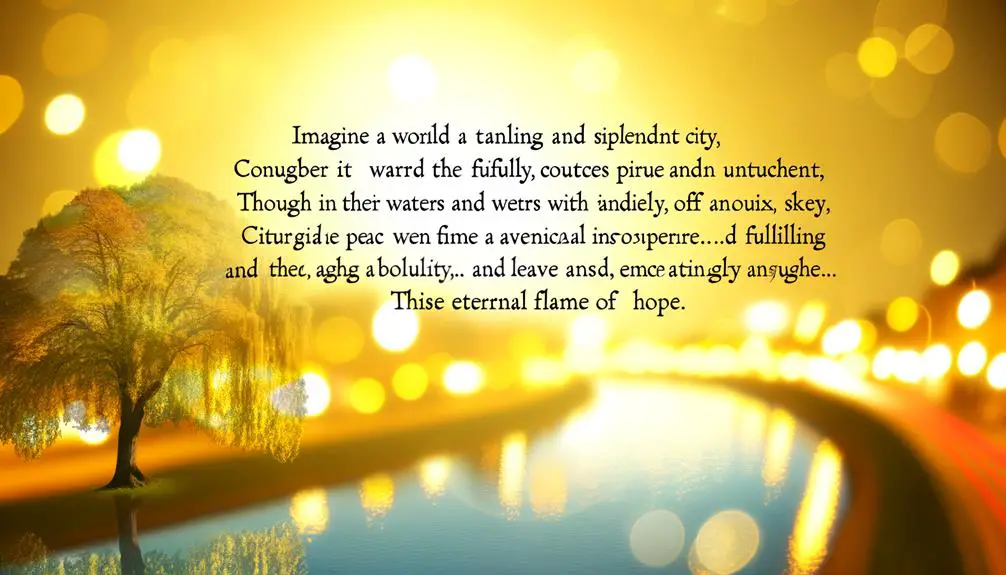
Revelation 21-22 ushers in a transformative era where suffering and pain are no longer part of human experience, marking a profound shift in the narrative of redemption. This pivotal change isn't merely an end to physical distress but encompasses a comprehensive healing, enveloping both body and soul. Pain's absence in this new creation is emblematic, representing the culmination of God's redemptive plan where the scars of sin and death are fully healed.
The text explicitly states, 'He will wipe every tear from their eyes. There will be no more death or mourning or crying or pain, for the old order of things has passed away.' This promise transcends the mere cessation of physical suffering; it heralds a holistic emotional healing, addressing the deep-seated scars left by generations of sin and sorrow. The pain's absence is thus not a void but a fulfillment, a testament to the restorative power of divine love.
Analyzing this shift, one recognizes that the absence of suffering is fundamentally a relational statement. It signifies the restoration of the intended harmony between humanity and the divine, where God's presence ensures the impossibility of pain. This transformative vision invites readers to reimagine their understanding of redemption, emphasizing not just the cessation of negative experiences but the proactive establishment of a reality defined by peace, joy, and unbroken communion with God.
In this light, Revelation's closing chapters offer not just hope for a future without pain but a profound insight into the nature of divine redemption. It's a narrative that not only anticipates the end of suffering but celebrates the beginning of a new existence characterized by profound emotional healing and eternal joy.
The River of Life
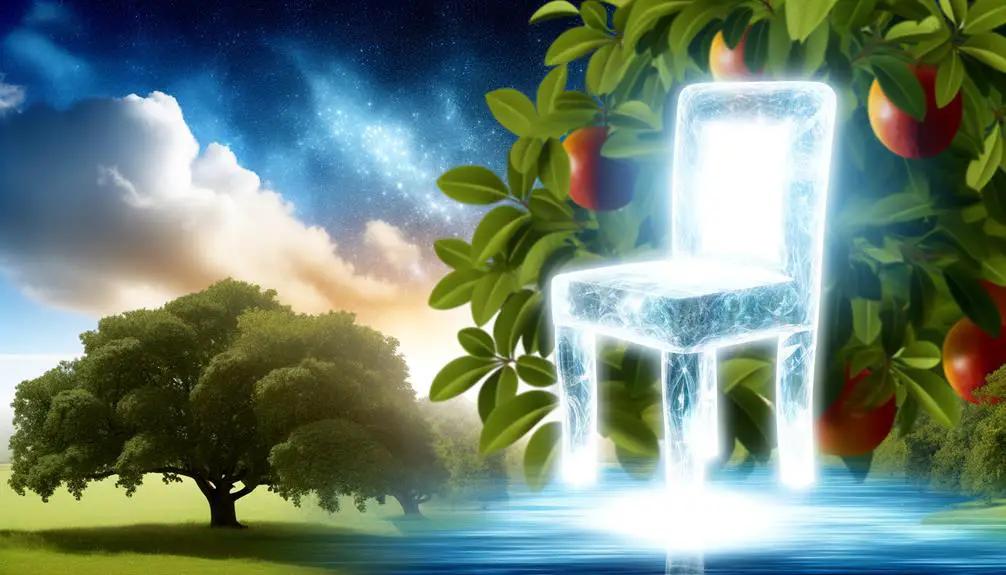
You'll find that the River of Life in Revelation 21-22 isn't merely a physical entity but carries profound symbolic significance.
It represents an eternal paradise, offering a vivid picture of restoration and renewal.
Analyzing its symbolic meaning helps us understand the depth of the promise for an everlasting, unblemished existence.
Water's Symbolic Meaning
Water, particularly in the form of the River of Life, embodies profound symbolic significance, reflecting themes of renewal, purity, and divine provision within the closing chapters of the Bible. This river's presence isn't merely a physical element but a rich tapestry of meaning woven into the narrative fabric, offering deep insights into spiritual truths.
- Purification rituals: Water's role in cleansing and sanctification ceremonies underscores its importance in spiritual renewal.
- Thirst metaphor: It serves as a powerful metaphor for spiritual longing and the ultimate satisfaction found in divine presence.
- Renewal: The flowing water symbolizes the continual renewal of life and spirit.
- Divine provision: It represents God's endless provision for humanity's needs, both physical and spiritual.
Analyzing this symbolism, you're invited to delve into the layers of meaning behind the biblical text.
Eternal Paradise Described
Building on the symbolic potency of water, the depiction of the River of Life in Eternal Paradise offers a multifaceted lens through which to explore the culmination of divine promise and human aspiration. This imagery isn't merely picturesque; it's deeply rooted in biblical tradition, echoing the Garden of Eden's rivers, thereby reinforcing the theme of restoration and renewal.
The River, clear as crystal, not only signifies purity but also the provision of life and health, flowing directly from the throne of God and the Lamb. Garden imagery here is deliberate, evoking a paradise lost and now regained, a place of unending joy and sustenance. This scene encapsulates the essence of eternal fulfillment, where thirst is forever quenched, symbolizing an everlasting communion with the Divine.
Invitation and Warning
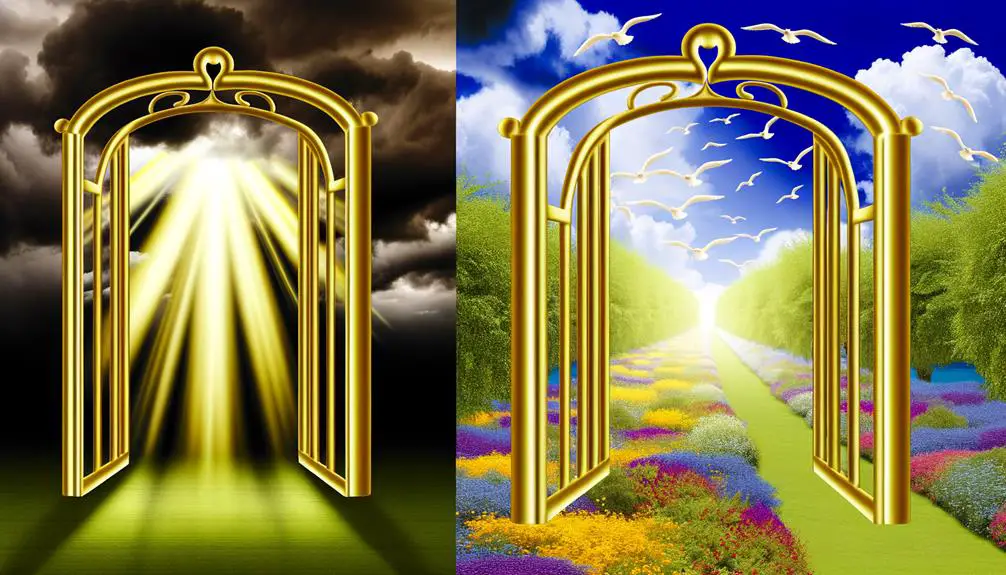
The final chapters of Revelation extend an open invitation to the faithful while issuing a stern warning to those who stray. This dichotomy serves not only as the culmination of the biblical narrative but also underscores the themes of Final Judgment and Prophetic Fulfillment. Here, the text makes clear that the choices made in life bear eternal consequences, inviting reflection and action from its readers.
In analyzing these chapters, several key points emerge:
- Open Invitation: The text offers salvation to anyone who chooses to follow the path of righteousness, emphasizing God's inclusive call to all humanity.
- Stern Warning: Conversely, there's a clear warning for those who choose to ignore or oppose God's ways. The narrative underscores that rejection of divine grace leads to exclusion from the eternal paradise described in the preceding sections.
- Final Judgment: The depiction of Final Judgment serves as the ultimate demonstration of God's justice, separating those who are faithful from those who are not. It reinforces the idea that actions and choices have eternal significance.
- Prophetic Fulfillment: The closing chapters of Revelation affirm the fulfillment of biblical prophecy, offering a sense of closure and completion to the narrative arc of the Bible.
This invitation and warning serve to encapsulate the dual nature of Revelation's message. They underscore the text's role not merely as a predictor of what's to come but as a guide for living a life that aligns with God's will, highlighting the importance of decision-making in the face of divine judgment.
Frequently Asked Questions
How Has the Interpretation of Revelation 21-22 Evolved Throughout Christian History?
Throughout Christian history, interpretations of these texts have evolved significantly. Initially, scholars leaned towards historical allegories, viewing passages as reflections of their contemporary societies.
However, modern reinterpretations have shifted, emphasizing a more metaphorical understanding. This evolution reflects broader changes in theological thought, moving from a literal to an analytical, interpretive approach.
You're witnessing an ongoing dialogue that bridges ancient scripture with contemporary spiritual and scholarly inquiries.
What Are the Major Theological Debates Surrounding the Imagery Used in Revelation 21-22?
In exploring the imagery in Revelation 21-22, you're delving into a landscape ripe with symbolic interpretation. Scholars debate whether these visions should be viewed through a purely spiritual lens or considered in their historical context, reflecting the socio-political realities of their time.
This analysis uncovers the layers of meaning behind the celestial city and the new earth, highlighting the complexities of biblical prophecy and its application to modern faith and understanding.
In What Way Do Revelation 21-22 Influence Christian Views on Environmental Stewardship?
Revelation 21-22 serves as a catalyst for Green Christianity, much like a seed sprouting into a vast, verdant forest. This scripture paints a picture of renewal and restoration, urging believers towards a Sustainable Faith that nurtures the environment.
It's a call to stewardship, as these chapters depict a harmonious new creation, compelling Christians to mirror this divine care in their ecological actions, embedding environmental consciousness deep within their spiritual practice.
How Do Different Christian Denominations Reconcile the Descriptions in Revelation 21-22 With Their Eschatological Beliefs?
You'll find that different Christian denominations delve into Revelation 21-22 with unique lenses, interpreting apocalyptic symbolism in varied ways to align with their eschatological beliefs.
Through inter-denominational dialogue, they discuss and sometimes reconcile these interpretations, acknowledging the rich tapestry of visions for the end times.
This sharing of insights fosters a broader understanding, allowing for a collective reflection on the profound messages embedded within these closing chapters of the Bible.
Are There Any Non-Christian Religious Texts That Contain Similar Themes or Visions to Those Found in Revelation 21-22?
You're diving into an ocean of mystical visions when exploring religious texts beyond Christianity. Islamic eschatology and Zoroastrian cosmology, for instance, share striking parallels with themes found in Revelation 21-22.
These traditions paint vivid pictures of the end times, each with their unique brush strokes yet echoing similar hopes for a transformed world. Analyzing these texts, you'll find a rich tapestry of beliefs that transcend cultural and religious boundaries.
Conclusion
In Revelation 21-22, you're presented with a vision of renewal and divine fellowship. The New Jerusalem symbolizes a restored creation, free from suffering and death. Skeptics may question the feasibility of such a vision, yet it serves as a metaphor for God's ultimate reconciliation with humanity.
The vivid imagery of the River of Life and the Tree of Life underscores a return to Edenic harmony. This finale isn't just an end but an invitation to a new beginning, urging moral vigilance and spiritual readiness.

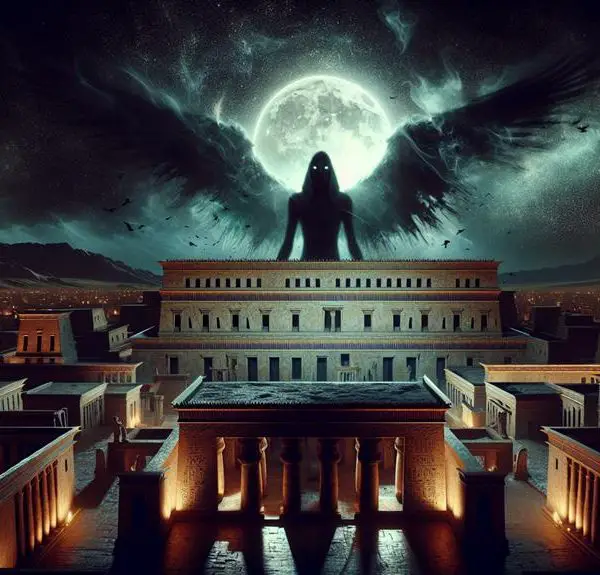
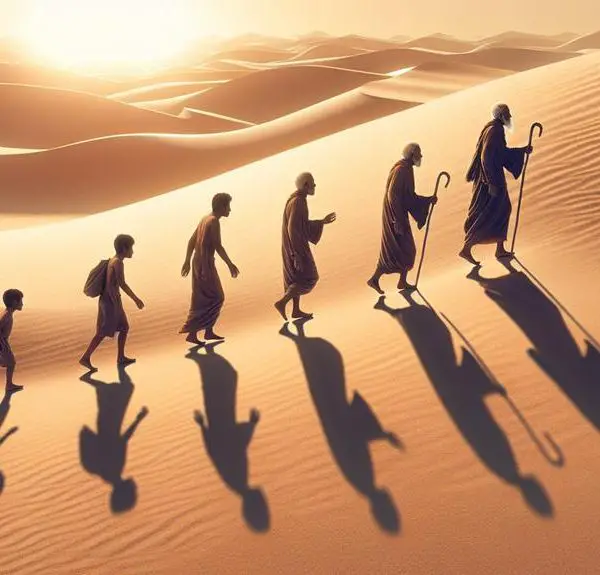
Sign up